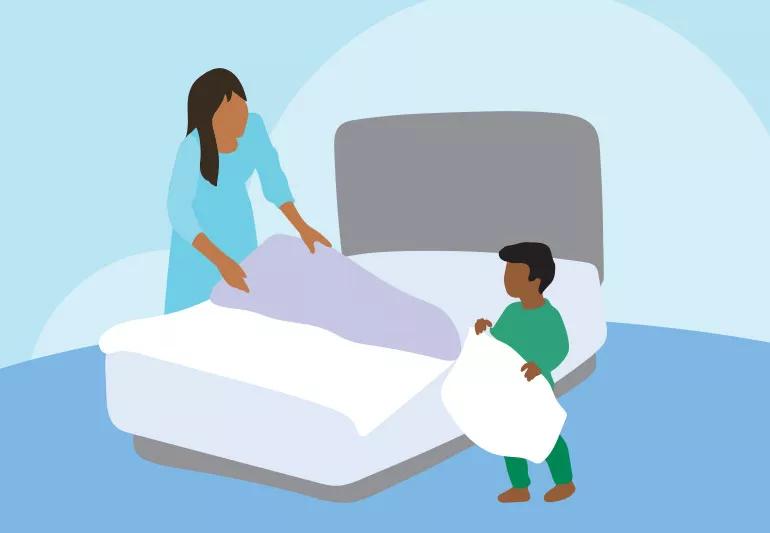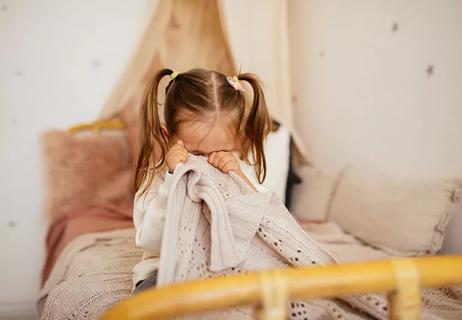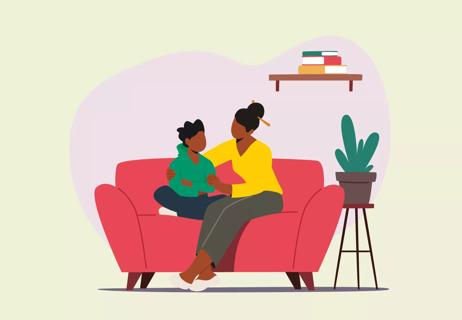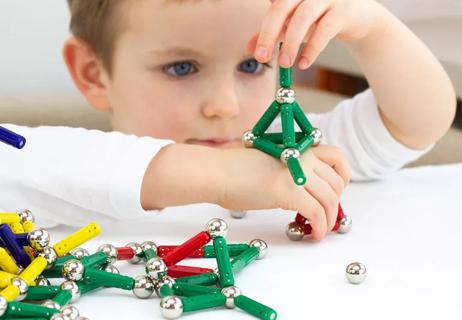Maturity and safety matter more than age

They started in a bassinet in your bedroom. Then on to the crib. Then, progressively lowering the crib. And now, with the crib as low as it goes, you’re wondering when the next step comes: When to transition to a toddler bed.
Advertisement
Cleveland Clinic is a non-profit academic medical center. Advertising on our site helps support our mission. We do not endorse non-Cleveland Clinic products or services. Policy
Moving out of the crib is a big change for your toddler — and for you. A big-kid bed comes with responsibility and a hefty reminder that your little peanut isn’t a baby anymore.
Beds are for big kids. And they shouldn’t be something to rush into until both you and your little one are ready. That said, there are some surefire signs that it’s time to move out of the crib. And plenty of advice for how to make the change easier on your family.
We talked with pediatrician Laura O’Connor, MD, about moving to a toddler bed (or any bed with rails to keep your kiddo safe). How do you know when it’s time? And how can you make the move to the bed as smooth as possible?
Most toddlers will switch from the crib to a bed somewhere between 18 months and 3 years old. That’s a pretty big range, and it’s flexible for a reason.
Every child is unique. Some talk earlier. Some walk later. Some are fussy, while others are more content. It’s all normal. And it’s also normal if your kid’s readiness for a bed looks a little different from other children their age.
“There’s no magic age when you say, ‘Now’s the time to move out of the crib’” Dr. O’Connor says. “It’s more about following your child’s cues. The age when they’re ready for that change will vary.”
Advertisement
So, the question of when the right time is to switch to a toddler bed isn’t a hard-and-fast rule. It’s going to be different for different kids.
Dr. O’Connor says there’s no harm in keeping your kid in their crib as long as it’s safe for them.
“Your child’s safety should be your number one concern when you consider their readiness to switch out of the crib,” she continues. “It’s a matter of weighing whether they’re safer in a crib or safer in a bed.”
Beds are easy to get out of. They’re easy to roll out of. They offer up very real independence that some toddlers take as an opportunity to get up to mischief. On the other hand, a toddler who’s outgrown their crib comes with dangers as well.
What are the red flags to look out for that a bed will offer up better, safer sleep? Dr. O’Connor shares a few.
Even with the crib mattress at its lowest setting, some little gymnasts still find ways to heave themselves over the railing. And probably scare the wits out of you in the meantime.
Breaking out is probably the most obvious sign that the crib isn’t cutting it anymore.
A study from the American Academy of Pediatrics says climbing over the crib rail can mean a drop of about 4.5 feet. Rolling out of a toddler bed, on the other hand, is more like 2 feet. So, if they’re going to get out, better to do it from a bed.
While the researchers said most injuries from crib falls aren’t too serious, they still reported injuries like cuts and bruises and even a few skull fractures and broken shoulders. Not what you want for your toddler.
Dr. O’Connor says a sleep sack could buy you some time. While not impossible to stand in, a sleep sack can make it more difficult for your child to stand up or climb. Of course, some little Houdinis can get out of a sleep sack, too, so it’s not a perfect solution for everyone.
Bottom line: If your kiddo is busting out of the crib, it’s time to move to a bed.
Even if your tot hasn’t made the move to break out of the crib, their height can put them at risk for a fall. The American Academy of Pediatrics says a child has outgrown their crib if:
Either of those scenarios makes it easier for your little one to climb out and should be a clue that it’s time to move to a bed.
Sleeping in a bed takes some self-control. There are distractions, like toys in their room, and the freedom to wander the house and see what everyone else is up to. Some kids are happy to follow the rules and stay in their beds. Others are eager to test the boundaries.
Advertisement
“A child who isn’t developmentally ready to stay in their bed can be a safety risk,” Dr. O’Connor notes. “Kids can get into all kinds of trouble left to their own devices while you sleep. If your child hasn’t mastered a good level of self-control, you might wait until they’re showing signs they can be trusted to fall asleep in bed and in stay in it all night.”
Those signs may include things like:
When your toddler starts asking about a bed (especially if they ask repeatedly), it may be a sign that they’re ready for a change. Of course, you don’t want to make the switch simply because they say so, but it’s worth taking their interest into consideration.
When your child asks about moving into a bed, use it as an opportunity to start talking about the expectations you have of them when they move out of their crib. Use their request as a conversation opener to talk about the rules of staying in a big-kid bed. That way, by the time they do move into a toddler bed, they have an idea of the ground rules.
Advertisement
It’s a common scenario. You have a baby on the way and aren’t interested in having two cribs in the house. So, you start thinking about moving your toddler to a bed to make room for the baby. Why shell out for a second crib if you don’t have to, especially if your toddler is ready (or almost ready) for a bed anyway? It’s a very rational thought process.
Dr. O’Connor says there are two routes you can take to make the change, depending on your toddler’s readiness.
One option is to make the change early, maybe even while you’re pregnant. That way, your older child has some time to get used to the bed before your baby comes. An early switch to the bed also means they’re less likely to resent the baby for taking the crib from them. Especially if your toddler likes their crib, you don’t want to give the impression that they have to give it up for the sake of their little sibling.
“Some kids tend to think of their crib as their safe space, so if you move them out and move a new baby in right away, you might wind up with a lot of jealousy,” Dr. O’Connor explains. “They already have to share you and share their home with a new baby. Giving up the crib could just be one thing too much.”
Alternatively, if your toddler isn’t quite ready to move to a bed while you’re still pregnant, you can buy yourself a few more months by having the baby sleep in a bassinet in your room. Babies are safe to sleep in a bassinet until they roll over or outgrow it (check the details from your manufacturer on size limitations). Using a bassinet for a bit gives the older child a little more time to mature and be ready for a toddler bed.
Advertisement
When you and your toddler are ready to make the move to a toddler bed — whether by choice or necessity — Dr. O’Connor suggests a few pieces of advice to make the transition easier.
A big-kid bed probably isn’t something you want to spring on your child when they come home from daycare one day. It’s likely to be smoother if they know the change is coming and can get excited about it. Kids love to know they’re in on the plan.
Talking about moving to a bed lets you have a conversation with them about what’s coming and what you expect. Talk with your child about:
Another way to get your toddler excited about their new bed is by allowing them to have some say in it. If you can, allow them to choose new sheets or a comforter in their favorite color or featuring a favorite animal or character. Or maybe they get to pick out a night light. You can also let them choose a special comfort item — like a small blanket or stuffed animal — to stay in their bed with them.
“When a child gets to have some say in how their bed will fit their tastes, it helps make them feel ownership and independence, which, developmentally, are very important to toddlers,” Dr. O’Connor explains.
Kids thrive on routine. If you already have a bedtime routine in place that works for you (or at least works most nights), stick to it. Changing up a bedtime routine can be jarring. Don’t rock the boat by introducing a new set of pre-sleep activities.
Don’t have a solid bedtime routine? Now’s the time to start.
Turn off electronics at least an hour before bedtime and then move into a consistent schedule of activities, in the same order, night after night. This will help your child wind down and cue sleepiness. You can do things like:
If you can avoid it, try to make the switch to a toddler bed separate from any other big changes in your child’s life. That includes events like potty training, moving, going to a new daycare and even going on vacation.
Let’s say it again: Kids thrive on routine. So, if you’re in the midst of another change, it’s probably best to introduce the bed another time. Stick to one big change at a time if you can.
Chances are you’ve already taken a good look around your house and childproofed everything that stood out. You have those little things that round out the sharp corners on your coffee table. Locked up the cabinets. Put a gate on the bottom of the stairs.
Knowing that your child can now get out of bed should be a chance to take another hard look at any other safety concerns, in and out of their room. It might sound silly, but get down on your knees to make yourself closer to their height, and take a good look around.
A few things to check for include:
If you can, start by transitioning to a toddler bed for naptime only until your kid gets used to the idea. This way, they can get practice having the freedom of a bed while you’re not fast asleep in your own.
For some families, this transition may happen at daycare or another childcare facility. If your child naps on a bed or cot outside of your home, ask their provider how it’s going. They also may share any special prompts or tactics they use that you can incorporate and reinforce new bedtime rules.
You may have already done the whole sleep training thing back when your baby was a few months old and working on learning self-soothing techniques. Much of what you learned then will apply as they move to a bed now.
Dr. O’Connor and the American Academy of Pediatrics suggest these methods to help your child sleep better in their bed:
Dr. O’Connor says that returning your child to their bed every time they get up is an important step to ensuring they understand the rules.
“Some families are OK with bed-sharing between parents and kids, but if that’s not your intention, it’s better to put an end to it before it starts,” Dr. O’Connor states. “If you don’t want your child sleeping in your bed, it’s better to not give in if they come into your room. It’s not easy to do, but consistency is important. Once sleeping in your bed becomes a habit, it’s a hard one to break.”
Dr. O’Connor points out that toddlers thrive on positive reinforcement. (Don’t we all?) So, a small prize or reward for a good job sleeping in their new toddler bed can be very motivating for a toddler.
A sticker chart, for example, can be a big help during the transition to a bed. For every night they stay in bed, they get a sticker. When they have a certain number of stickers, they can get a small reward, like going to the park or a special meal of their choice. Start with a small reward for a small number of stickers and work your way up to making them earn stickers to get the payoff.
Moving to a toddler bed is a big deal in a kid’s life. It’s an important step in their growing independence and responsibility. Don’t rush it. Wait for them to cue you that it’s time. And when the time comes, talk about it and be ready to enforce some rules.
Learn more about our editorial process.
Advertisement

Hydration and sleep are as important as avoiding dirty surfaces

These visits include getting important vaccines and checking on developmental milestones

Listen to your child to help them identify their fear and name it, but don’t reinforce it

Have a consistent routine and heap on the positive reinforcement

This parenting style relies on empathy, understanding and respect

Expert advice on helping your child to get better, faster
Get expert tips on prevention and treatment

Know when your child needs medical attention

Type 2 diabetes isn’t inevitable with these dietary changes

Applying a hot or cold compress can help with pain